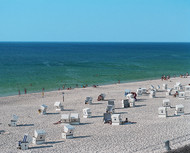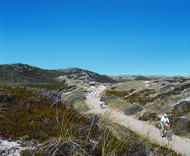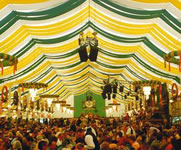
Sylt, whose maritime climate is influenced by the gulf stream, covers an area of approx. 100 km², making it the largest and most northerly of Germany's North Sea islands. Geographically, it is on the same latitude as the southernmost point of Alaska. Around eight thousand years ago, it became separated from the mainland to which it is now linked via the Hindenburg causeway. The island has just under forty kilometres of the finest sandy beaches along its west coast, with colourful wicker beach chairs, booming surf and air that sparkles like champagne.
The ideal place to forget all your cares, relax and enjoy the magnificent panoramic sea views. Take an occasional dip in the sea, join in with sporting activities and soak up the great atmosphere – then, in the evening, watch the sunset turn the sky and sea into a canvas drenched in colour. Just another typical day on the beach on the island of Sylt. You'll find tranquil coastal mudflats in the east, as well as unspoilt dunes, verdant dykes, flowering heathland and majestic cliffs. The perfect blend of daydreams and nightlife, hubbub and seclusion. On a trip to Sylt, you'll find a new surprise around every corner.

Measuring approx. 40 km in length and just under 500 metres wide in certain places, the island of Sylt lies just off the Schleswig-Holstein coast like a gigantic breakwater. Sylt was first mentioned in the 13th century. However, the numerous tumuli here show that there were prehistoric settlements on the island. For centuries the islanders made their living as sailors, pirates and whalers. Then, the people of Sylt discovered tourism as a source of income. People began coming to bathe at the newly opened seaside resort of Westerland in 1857. There are eleven villages on Sylt today, each with its own particular charm, such as idyllic Keitum with its thatched cottages and neatly kept farmer's gardens, as well as the island's lively centre Westerland, which is now a sizeable town.
The island also has a wealth of unspoilt countryside. Almost half of the island now consists of protected sites or conservation areas. The island of Sylt has many different faces. There is a Sylt for affluent society and a Sylt for the really rich, there is a Sylt for spa visitors and a Sylt for pleasure-seekers. Some come for rest and relaxation, while others come to enjoy good food and soak up the rays. Despite being so small, the island certainly has a lot to offer. You just have to know where to look! There's something for almost everyone on the island of Sylt.
 Skip to content
Skip to navigation
Skip to subnavigation
Skip to search
Skip to content
Skip to navigation
Skip to subnavigation
Skip to search






